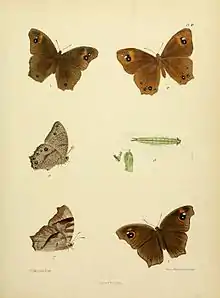| Common evening brown | |
|---|---|
 | |
| Wet-season form | |
 | |
| Dry-season form | |
| Scientific classification | |
| Domain: | Eukaryota |
| Kingdom: | Animalia |
| Phylum: | Arthropoda |
| Class: | Insecta |
| Order: | Lepidoptera |
| Family: | Nymphalidae |
| Genus: | Melanitis |
| Species: | M. leda |
| Binomial name | |
| Melanitis leda | |
| Synonyms | |
| |
Melanitis leda, the common evening brown,[1][2] is a common species of butterfly found flying at dusk. The flight of this species is erratic. They are found in Africa, South Asia and South-east Asia extending to parts of Australia.[1][2]
Description

Wet-season form: Forewing: apex subacute; termen slightly angulated just below apex, or straight. Upperside brown. Forewing with two large subapical black spots, each with a smaller spot outwardly of pure white inwardly bordered by a ferruginous interrupted lunule; costal margin narrowly pale. Hindwing with a dark, white-centred, fulvous-ringed ocellus subterminally in interspace two, and the apical ocellus, sometimes also others of the ocelli, on the underside, showing through.[3]
Underside paler, densely covered with transverse dark brown striae; a discal curved dark brown narrow band on forewing; a post-discal similar oblique band, followed by a series of ocelli: four on the forewing, that in interspace 8 the largest; six on the hindwing, the apical and subtornal the largest.[3][4]
Dry-season form: Forewing: apex obtuse and more or less falcate; termen posterior to falcation straight or sinuous. Upperside: ground colour similar to that in the wet-season form, the markings, especially the ferruginous lunules inwardly bordering the black sub-apical spots on forewing, larger, more extended below and above the black costa. Hindwing: the ocellus in interspace 2 absent, posteriorly replaced by three or four minute white subterminal spots.[3]
Underside varies in colour greatly. Antennae, head, thorax and abdomen in both seasonal forms brown or greyish brown: the antennae annulated with white, ochraceous at apex.[3]
Ecology
Resident butterflies are known to fight off visitors to the area during dusk hours.[5] This chase behaviour is elicited even by pebbles thrown nearby.[6]
The caterpillars feed on a wide variety of grasses including rice (Oryza sativa), bamboos, Andropogon, Rotboellia cochinchinensis,[7] Brachiaria mutica,[7] Cynodon, Imperata, and millets such as Oplismenus compositus,[8] Panicum and Eleusine indica.[9]
Adults feed mainly on nectar, and in rare cases visit rotting fruits.[10]
Image gallery
 Upperside pattern
Upperside pattern.JPG.webp) Wet season
Wet season Dry season
Dry season_dry_season_forms_composite.jpg.webp) M. l. ismene dry season forms, Nepal
M. l. ismene dry season forms, Nepal_%E2%80%93_Common_Evening_Brown.jpg.webp)
References
- 1 2 Varshney, R.K.; Smetacek, Peter (2015). A Synoptic Catalogue of the Butterflies of India. New Delhi: Butterfly Research Centre, Bhimtal & Indinov Publishing, New Delhi. pp. 162–163. doi:10.13140/RG.2.1.3966.2164. ISBN 978-81-929826-4-9.
- 1 2 Savela, Markku. "Melanitis leda (Linnaeus, 1758)". Lepidoptera and Some Other Life Forms. Retrieved July 2, 2018.
- 1 2 3 4
 One or more of the preceding sentences incorporates text from this source, which is in the public domain: Bingham, Charles Thomas (1905). Fauna of British India. Butterflies Vol. 1. pp. 158–159.
One or more of the preceding sentences incorporates text from this source, which is in the public domain: Bingham, Charles Thomas (1905). Fauna of British India. Butterflies Vol. 1. pp. 158–159. - ↑
 One or more of the preceding sentences incorporates text from this source, which is in the public domain: Moore, Frederic (1893–1896). Lepidoptera Indica. Vol. II. London: Lovell Reeve and Co. pp. 118–125.
One or more of the preceding sentences incorporates text from this source, which is in the public domain: Moore, Frederic (1893–1896). Lepidoptera Indica. Vol. II. London: Lovell Reeve and Co. pp. 118–125. - ↑ D. J. Kermp (2003). "Twilight fighting in the evening brown butterfly, Melanitis leda (L.) (Nymphalidae): residency and age effects". Behavioral Ecology and Sociobiology. 54 (1): 7–13. doi:10.1007/s00265-003-0602-7. S2CID 36085557.
- ↑ D. J. Kemp (2002). "Visual mate searching behaviour in the evening brown butterfly, Melanitis leda (L.) (Lepidoptera: Nymphalidae)" (PDF). Australian Journal of Entomology. 41 (4): 300–305. doi:10.1046/j.1440-6055.2002.00311.x.
- 1 2 S. Kalesh & S. K. Prakash (2007). "Additions of the larval host plants of butterflies of the Western Ghats, Kerala, Southern India (Rhopalocera, Lepidoptera): Part 1". Journal of the Bombay Natural History Society. 104 (2): 235–238.
- ↑ Krushnamegh Kunte (2006). "Additions to known larval host plants of Indian butterflies" (PDF). Journal of the Bombay Natural History Society. 103 (1): 119–120.
- ↑ Gaden S. Robinson; Phillip R. Ackery; Ian J. Kitching; George W. Beccaloni; Luis M. Hernández (2007). "HOSTS - a Database of the World's Lepidopteran Hostplants". Retrieved September 27, 2010.
- ↑ K. C. Hamer; J. K. Hill; S. Benedick; N. Mustaffa; V. K. Chey; M. Maryati (2006). "Diversity and ecology of carrion- and fruit-feeding butterflies in Bornean rain forest". Journal of Tropical Ecology. 22 (1): 25–33. doi:10.1017/S0266467405002750. S2CID 86365463.
